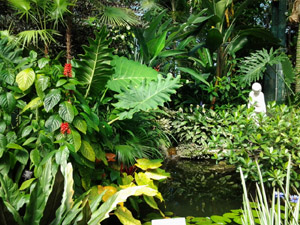 Lincoln Park Conservatory is another one of those nineteenth-century treasures still to be found in Chicago. It’s a glass house built between 1890 and ’95, located just east of Stockton Drive about a block south of Fullerton Parkway, off the northwest corner of Lincoln Park Zoo. The west side of the Conservatory proper and its support buildings is graced by a series of small gardens featuring pines, spruces, junipers and other conifers from around the world, interspersed with deciduous shrubs and trees. These gardens continue around to flank the entrance.
Lincoln Park Conservatory is another one of those nineteenth-century treasures still to be found in Chicago. It’s a glass house built between 1890 and ’95, located just east of Stockton Drive about a block south of Fullerton Parkway, off the northwest corner of Lincoln Park Zoo. The west side of the Conservatory proper and its support buildings is graced by a series of small gardens featuring pines, spruces, junipers and other conifers from around the world, interspersed with deciduous shrubs and trees. These gardens continue around to flank the entrance.
The “main room” is the Palm House, fifty feet high at the center, housing a profusion of palms and other tropical plants; the first sight is a pool with waterlilies and other aquatic plants, and goldfish. (Lots of goldfish in the Conservatory, and please don’t throw coins into the pools.) The plantings include not only palms but bananas, birds of paradise, gingers, gardenias, and other tropical plants, most of some economic value. The path leads around the central planting to the entrance to the Fern Room, devoted almost entirely to non-flowering plants – ferns, mosses, selaginellas, cycads, and the like. As the sign notes, a small dinosaur would feel very much at home here. (Although I’m not sure that we need the small toy dinosaurs hidden in the foliage to reinforce the point.) You’re allowed to throw coins in these pools – no fish.
From there, you enter the Orchid House, featuring orchids, bromeliads, and epiphytic cactus. (Another pool, this one with koi.) The orchid collection is composed largely of Phalaenopsis, Cattleya and Dendrobium hybrids (the result of donations, I’m sure), which I find rather humdrum, but there are treasures – recently there were several hanging baskets with blooming Stanhopeas, which look like birds of prey diving on a victim, and there are often baskets with Gongora quinquinervis and related species, which look like strings of exotic insects. (Hint: be sure to look up as you walk through, or you’re likely to miss a spectacular Vanda in bloom.) The east wall is covered with Vanilla vines, with flowers like huge yellow daffodils, punctuated by a few Oncidiums, the “Dancing Lady” orchids. And the cactus can be quite spectacular. (Yes, I’m an orchid freak, and I especially like the ones with little brown flowers that look like bugs.)
Next is the Show House, home to a series of exhibitions throughout the year, some of them quite engaging – the annual Christmas exhibition features models of Chicago buildings made out of plant materials – twigs, leaves, seed pods, and the like – that somehow manage to look like gingerbread, along with toy trains that wend their way through the foliage. The exit leads once again to the Palm House, with the path leading around the west side of the main area to the exit.
One notable feature of the Conservatory is the art. The Show House usually has works by local sculptors, and the Fern Room hosts a series of sound installations that evoke everything from primeval swamps to (distant) city life.
As usual, I would like more information on the signage, but considering the number and variety of plants on display, Conservatory staff has done an excellent job of letting visitors know what’s what. The Conservatory is free (unless there’s a special event) and open every day from 9 a.m. to 5 p.m., and guided tours can be arranged.
And there’s always something in bloom.
